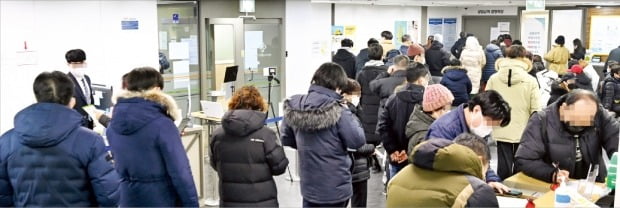
In the aftermath of Corona 19, the number of employed fell by 218,000 last year, which is the largest decline since the financial crisis. A long line is standing in front of the unemployment benefit presentation hall held at the Seoul West Branch of the Ministry of Employment and Labor in Dohwa-dong, Seoul on the 13th. / Reporter Kang Eun-gu [email protected]
In the aftermath of the novel coronavirus infection (Corona 19), the number of employed people last year decreased by 218,000 from the previous year. This is the largest decline in 22 years since 1998, the time of the financial crisis. In particular, last month, employment declined to 630,000 in the aftermath of the third spread of Corona 19.
The government decided to overcome the employment shortage this year by selecting more than 60,000 new employees of public officials and public institutions and supplying 1,040,000 temporary public jobs. Based on this, it plans to achieve the goal of increasing the number of employed 150,000 this year. However, it is pointed out that the recovery of employment will be difficult if the corona 19 spread is not caught and the policy of confining companies, the main agent of job creation, is repeated.
Maximum in 22 years of decline in employed

According to the’December 2020 and Annual Employment Trends’ released by the National Statistical Office on the 13th, the number of employees employed per year last year was 26.94,000, down 218,000 from a year ago. This is the largest decline since 1998 (-1276,000 people).
Since the start of preparing statistics on employed people in 1963, the number of employed people has decreased only four times before. It was 1984 (-76,000 people) when the oil shock hit, 1998 during the foreign exchange crisis, 2003 (-10,000 people) during the credit card crisis, and 2009 (-87,000 people) during the global financial crisis.
By age, the number of employed decreased in all age groups except those over 60. Those in their 30s (-165,000 people) and 40s (-158,000 people), which are the’economic waist’, were hit hard. The number of employees in their 20s and 50s decreased by 146,000 and 88,000, respectively. On the other hand, 375,000 people in their 60s or older increased. It is interpreted as the effect of supplying 740,000 jobs, 100,000 more than the previous year, for’old man jobs’ created by tax.
By industry, the number of employed decreased significantly in wholesale and retail business (160,000 people), accommodation and restaurant business (-159,000 people), and education service business (-86,000 people). The manufacturing industry (-53,000 people) and finance and insurance (-22,000 people), which are considered relatively high-quality jobs, were also unable to avoid a decline in employment.
Last year, the number of unemployed people (1.18,000) was the highest after 2000, when statistics were compiled based on the current standards. The unemployment rate (4.0%) is the worst since 2001 (4.0%). The employment rate (60.1%) was the lowest after 2013 (59.8%), and the growth rate of the inactive population (455,000 people) was the highest after 2009 (495,000 people).
I’m going to increase jobs in the public sector,
To make matters worse, the employment situation at the end of the year worsened. Looking at the monthly decrease in employed people, it fell from 421,000 in October to 273,000 in November, but soared to 628,000 last month. This is the aftermath of the strengthening of social distancing measures. To find a time when the monthly employment decline was greater than this, we need to go back to February 1999 (-658,000).
The government, which fell on fire at the foot, came up with a job plan at the 26th meeting of the Emergency Economic Company headquarters. The key is’increasing public jobs’. It has decided to hire more than 36,500 new public officials this year. Kim Yong-beom, the first vice minister of the Ministry of Strategy and Finance, said, “The number of new recruits in public institutions will also increase from 25,700 last year.”
It will also supply 1042,000 direct jobs this year, which are temporarily operated by the government finances. In particular, it decided to hire 760,000 people, or 72.9% of the total by February. A plan to expand women’s jobs will also be prepared within the first quarter of this year.
Deputy Prime Minister and Minister of Equipment, Hong Nam-ki, said, “Due to the spread of Corona 19, a difficult employment situation will continue until January to February.”
However, experts predicted that the employment crisis will continue this year. So-young Kim, a professor of economics at Seoul National University, pointed out, “Only when we are convinced that the spread of Corona 19 will stop, private companies will increase recruitment. Professor Seong Tae-yoon of the Yonsei University Department of Economics said, “There is a limit to employment improvement to increase public sector jobs.”
Reporter Seo Min-jun/Koo Eun-seo [email protected]
